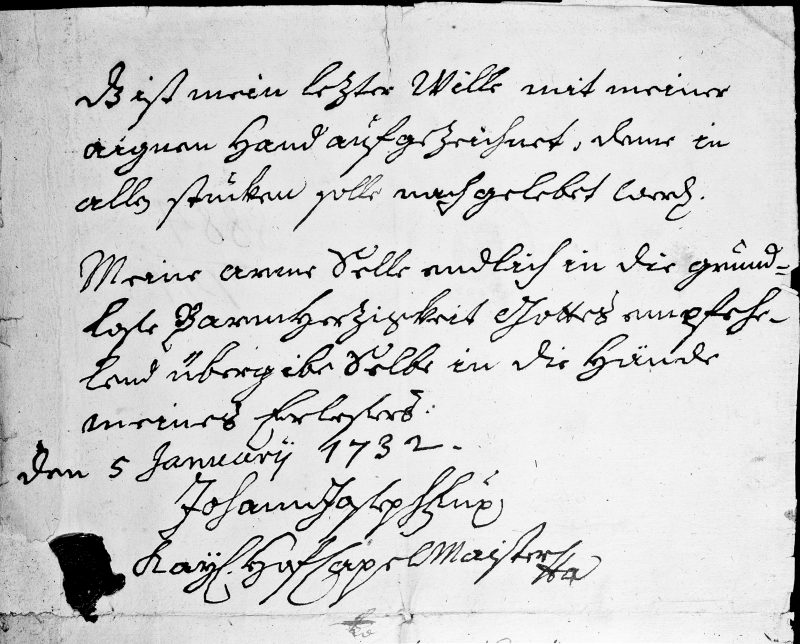Biographical Data Johann Joseph Fux
- ca. 1660 born in Hirtenfeld near St. Marein/Styria (today community of Nestelbach), son of Andreas Fux, a farmer and the colliery’s church administrator (Zechprobst)
- first musical education probably by the teacher of St. Marein
- by 1680: attending Jesuit University Graz
- 1681: freelance student at the Ferdinandeum Graz, participation in church music at the Hofkirche Graz
- 1683: departure from boarding school shortly before the end of the three-year commitment; he probably did not want to follow the determined way entering into the clergy.
- December 28, 1683: Enrollment at the Jesuit University Ingolstadt, law studies
- August 20, 1685 until the end of 1688 at the latest: organist in St. Moritz, Ingolstadt
- 1693 or 1695: dedication of the Missa SSmae Trinitatis to Emperor Leopold I on the occasion of either the consecration of the Holy Trinity Column at Graben/Vienna (1693) or the laying of the foundation stone of the Trinitarierkirche/Alser Straße in Vienna (1695)
- June 5, 1696: marriage with Clara Juliana Schnitzenbaum, daughter of a civil servant, in Vienna; the couple remains childless and adopts two children of half-brother Peter Fux: Eva Maria and Matthäus Fux
- by 1698 to 1702: organist at the Schottenstift Vienna
- April 1698–1705: Court composer of Emperor Leopold I (title made retroactive from the beginning of 1698)
- 1701: publication of Concentus musico-instrumentalis (Felseckers Erben, Nuremberg) (source; German translation of the preface)
- 1705: appointment as second chapel master at the Maria Pötsch icon in St. Stephen’s, Vienna
- January 1712–1714: first chapel master at St. Stephen’s. Tasks: To perform and – if necessary – compose masses and motets for the High Mass
- October 1713: vice chapel master of Emperor Charles VI (title made retroactive from October 1711), and master of the music chapel of the emperor’s widow Wilhelmine Amalie (until 1718)
- ca. 1713: beginning to suffer from gout, with increasing reduction of compositional activity by the 1720s
- February 7, 1715: appointment as first chapel master of Emperor Charles VI. Tasks: Musical direction of performances; composing for masses and divine offices as well as for special events (coronations, weddings, births, deaths, etc.), table music; organization of musical performances; responsibility for recruitment, salary and retirement benefits of the members of the chapel; involvement in administration and finances; writing evaluations of different musicians. Fux also accepts orders of compositions for monasteries outside Vienna (e.g. Collegiate Church of the Crusaders in Prague, St. Vitus in Prague)
- 1716: Angelica vincitrice di Alcina for the birth of the successor to the throne, Archduke Leopold Johann
- 1717: Fux defends the Hexachord doctrine in the “solmisation dispute” with Johann Mattheson
- 1719: publication of Elisa, Festra teatrale per Musica (Jeanne Roger, Amsterdam)
- March 5, 1720: exequia for the emperor’s widow Eleonora Magdalena, with the “Kaiserrequiem” by Fux; later performances of this composition in 1736 (for the funeral for Prince Eugene of Savoy) and in 1740 (for the funeral for Emperor Charles VI)
- 1720: Componimento da camera per musica Psiche, which Fux cannot complete (because of illness?) in time for the name day of Empress Elisabeth Christine on November 19; the missing numbers are set to music by Antonio Caldara. Fux completes his composition for the 1722 performance on the birthday of Emperor Charles VI
- 1722: Le nozze di Aurora, Festa teatrale for the wedding of the archduchess Maria Amalie with elector Karl Albrecht of Bavaria.
- 1723: Costanza e fortezza, festival opera for the birthday of Empress Elisabeth Christine, performances in Prague at the coronation of Charles VI as king of Bohemia and at the hereditary homage
- 1725: publication of Gradus ad Parnassum by Johann Peter van Ghelen, Vienna. - Performance of Giunone placata for the nameday of Empress Elisabeth Christine.
- 1731: death of Fux’s wife
- August 28, 1731: performance of Enea negli Elisi for the birthday of Empress Elisabeth Christine
- January 5, 1732: drawing up of Fux’s will, appointment of the adopted children Eva Maria and Matthäus as heirs; the musical legacy (instruments, manuscripts, library) goes to the nephew Matthew and is subsequently lost
- February 13, 1741: Fux dies at the age of 81 in Vienna and is buried on February 15, 1741 in the catacombs of St. Stephen’s; in the 19th century they are cleared and Fux’s grave is not preserved

J. J. Fux, Testament (end).
© by courtesy of Österreichische Nationalbibliothek, Bildarchiv und Grafiksammlung (POR) LW 71821-C
See Thomas Hochradner, Thematisches Verzeichnis der Werke von Johann Joseph Fux Band I, Wien: Hollitzer 2016; Thomas Hochradner, art. Johann Joseph Fux, in MGG2, Personenteil Bd. 7, Kassel etc.: Bärenreiter 2002, col. 303–319; Rudolf Flotzinger (ed.), Johann Joseph Fux. Leben – musikalische Wirkung – Dokumente, Graz: Leykam 2015.
Documents concerning the Fux reception and performances can be found in the collection by Gerhard Hofer: www.fux-archiv.com
